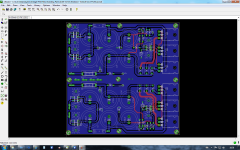Mister Terry have you seen mister Carlos videos? he operate Dx Super A with AA batteries
I mean this does not mean that your are going to do it, he is just showing that Dx Super A can operate at that minimum supply voltage
Audio amp. powered by Triple A batteries - Amp. movido à pilha - YouTube
I did it too with a small transformer and it even operates too meaning there is a lot options but fallow mister Carlos suggestions 🙂
Regards
Juan
I mean this does not mean that your are going to do it, he is just showing that Dx Super A can operate at that minimum supply voltage
Audio amp. powered by Triple A batteries - Amp. movido à pilha - YouTube
I did it too with a small transformer and it even operates too meaning there is a lot options but fallow mister Carlos suggestions 🙂
Regards
Juan
Last edited:
I just wondered because he said the power supply needed to be able to sustain a 10A load. I don't plan to be anywhere near that.
Thanks, Terry
Thanks, Terry
ohooo I see mister Terry the idea of the regulator is to keep a constant and steady power a reservoir when power is need it, I was checking a few minutes ago and the power consumption playing soft music is about 327mA (330mA) on the positive rail the regulator should be just right.
Regards
Juan
Regards
Juan
Last edited:
Juan Vargas new email adress is
juanvargasdiaz1970@yahoo.com
In this year, when Juanito born, i was already in the army.
Young Juanito.
Carlos
juanvargasdiaz1970@yahoo.com
In this year, when Juanito born, i was already in the army.
Young Juanito.
Carlos
Attachments
Then in 2005 I join the Army later 2 deployments to Iraq, I never going to forget, thanks battle buddy 🙂
Regards
Juan
Regards
Juan
Dx Supply is included in the package.... Juan have amplifier pcboards
And also power supply pcboards.
This is good to clarify.
Also the Dx Supply can be used together other amplifiers, the output voltage is adjustable.
regards,
Carlos
And also power supply pcboards.
This is good to clarify.
Also the Dx Supply can be used together other amplifiers, the output voltage is adjustable.
regards,
Carlos
Hi Guys,
I have been using my DX Supply with an SKA GB150. I am using a 40-0-40VAC transformer and dialing it down to +/-50vDC rails. It is feeding both channels which are set to 250mA per rail each. I had fairly large heatsinks installed on the supply but they never even got warm to the touch. I wanted to reduce the size to make it easier to install in the case I am building for the SKA so I remove the heatsinks and just cut some pieces of 1/4" x 2-1/2" x 6" aluminum bar and attached them to the MJL21193(PNP) MJL21194(NPN) outputs. They still barely get warm to the touch even after prolonged playing. So I am curious, what does it take for the outputs to need large heatsinking, Class A?
Thanks, Terry
I have been using my DX Supply with an SKA GB150. I am using a 40-0-40VAC transformer and dialing it down to +/-50vDC rails. It is feeding both channels which are set to 250mA per rail each. I had fairly large heatsinks installed on the supply but they never even got warm to the touch. I wanted to reduce the size to make it easier to install in the case I am building for the SKA so I remove the heatsinks and just cut some pieces of 1/4" x 2-1/2" x 6" aluminum bar and attached them to the MJL21193(PNP) MJL21194(NPN) outputs. They still barely get warm to the touch even after prolonged playing. So I am curious, what does it take for the outputs to need large heatsinking, Class A?
Thanks, Terry
Terry, try a sinewave into a dummy load at moderate to high power. If the pass transistors don't get warm/hot after 10 minutes I'd be suprised and suspect something amiss.
I'm suggesting you play a sinewave through the amplifier connected to the power supply to generate sufficient current draw through the pass transistors in your power supply. If you are playing music at normal levels through a medium power Class A/B amplifier, and the quiescent current in the normal range, then the average power draw is going to be low. If you want to see the pass transistors' heatsinks get hot to confirm proper operation, then play the music really really loud or drive the current into a dummy load.
OK, I see what you are saying. I guess that was my point. I did play the amp really loud for and extended period of time to make sure the bars(heatsinks) would be sufficient. The heatsinks on the SKA were plenty hot but the heatsinks on the PSU were barely warm. I was just wondering because I saw some pictures of some pretty big heatsinks on these PSU's and wondered if any of them got hot and if so, what amp were they driving. Mine doesn't even breaks a sweat.
Thanks, Terry
Thanks, Terry
That low heat dissipation implies low Vdrop through the regulators when delivering 250mA of Iq.
Normal music playing does not increase the average current draw that much.
But the low Vdrop could be a problem.
What is the regulator Vdrop when mains is at maximum tolerance?
What is the regulator Vdrop when mains is at minimum tolerance?
If the Vdrop is high the regulator will run hotter.
If the Vdrop is low then the regulator will drop out. That is what you must check.
Normal music playing does not increase the average current draw that much.
But the low Vdrop could be a problem.
What is the regulator Vdrop when mains is at maximum tolerance?
What is the regulator Vdrop when mains is at minimum tolerance?
If the Vdrop is high the regulator will run hotter.
If the Vdrop is low then the regulator will drop out. That is what you must check.
That low heat dissipation implies low Vdrop through the regulators when delivering 250mA of Iq.
Normal music playing does not increase the average current draw that much.
But the low Vdrop could be a problem.
What is the regulator Vdrop when mains is at maximum tolerance?
What is the regulator Vdrop when mains is at minimum tolerance?
If the Vdrop is high the regulator will run hotter.
If the Vdrop is low then the regulator will drop out. That is what you must check.
Hi Andrew,
Not sure what you are referring to with Vdrop. It is a 40-0-40vAC transformer. With just normal bridge and filter it produces around +/-58vDC. I have the DX supply adjusted down to +/-50vDC for the SKA. It holds right there seemingly regardless of what level the amp is playing at. Almost not voltage change at all.
Thanks, Terry
58V supply and 50Vdc output tells you that the Vdrop across the regulator is 8Volts.
That voltage varies. It varies a lot.
As your current draw changes the Vdrop changes.
As your mains supply voltage changes the Vdrop changes.
You need to know that the regulator never falls out of regulation.
You do this either by modeling or by measurement.
Find out how low the Vdrop becomes in worst case operation.
Find out how high the Vdrop becomes for worst case regulator heat creation.
That voltage varies. It varies a lot.
As your current draw changes the Vdrop changes.
As your mains supply voltage changes the Vdrop changes.
You need to know that the regulator never falls out of regulation.
You do this either by modeling or by measurement.
Find out how low the Vdrop becomes in worst case operation.
Find out how high the Vdrop becomes for worst case regulator heat creation.
Maximum current info is needed to see if the Dx Supply
Will be good to do this job....it was made to 4 to 5 volts of voltage drop (voltage in the colector minus voltage in the emitter....or input voltage minus output voltage)... was made to the Dx Amplifier,
Of course other amplifier can use it, but we must check if the supply can face the power or not..and this depends on the current and voltage drop.
This voltage drop is multiplied by the maximum current..then we gonna have the power ...and this must be checked to know if the supply will hold the job without fail...transistors have maximum current, maximum voltage and as a result maximum power, and this must be checked.
Power into the series pass transistors, to each rail, is the rail current multiplied by that particular rail voltage drop.
You said 58 will go in and 50 will be the the adjusted voltage...so...we have 8 to multiply by the maximum current the SKA will drain from the suipply (full power at 2 ohms current)..... then we gonna see if your transistors (type and quantity) will be enough.
In the reality, dear Terry, this calculation is for "worst case scenario", because real world the input voltage (58 volts) will drop depending the current drained)...so...we have a safe margin after the calculation based in 58 volts.
regards,
Carlos
Will be good to do this job....it was made to 4 to 5 volts of voltage drop (voltage in the colector minus voltage in the emitter....or input voltage minus output voltage)... was made to the Dx Amplifier,
Of course other amplifier can use it, but we must check if the supply can face the power or not..and this depends on the current and voltage drop.
This voltage drop is multiplied by the maximum current..then we gonna have the power ...and this must be checked to know if the supply will hold the job without fail...transistors have maximum current, maximum voltage and as a result maximum power, and this must be checked.
Power into the series pass transistors, to each rail, is the rail current multiplied by that particular rail voltage drop.
You said 58 will go in and 50 will be the the adjusted voltage...so...we have 8 to multiply by the maximum current the SKA will drain from the suipply (full power at 2 ohms current)..... then we gonna see if your transistors (type and quantity) will be enough.
In the reality, dear Terry, this calculation is for "worst case scenario", because real world the input voltage (58 volts) will drop depending the current drained)...so...we have a safe margin after the calculation based in 58 volts.
regards,
Carlos
Last edited:
I played it for two days straight and nothing got even warm in the PSU. I have increased the voltage to +/-52V because that is what Greg Ball suggested. I don't hear any difference. I'm not going to take a chance and play the amp into 2ohm at full volume. It handles 4ohm just fine.
Final layout For Dx supply
Hi All
can any one have have Final PCB layout for DX supply on Greg's site
please shear
Hi All
can any one have have Final PCB layout for DX supply on Greg's site
please shear
Not completed yet but here a preview of an other approach of the PSU and an audio friend is helping.It is based on a Thel Audio design
Attachments
Last edited:
Not completed yet but here a preview of an other approach of the PSU and an audio friend is helping.It is based on a Thel Audio design
Hi meanman1964
I Want Simple Dx supply layout for one Channel for Dx standard or Dx Blame ST not regulated with dual Channel.You have that one
Thanks for your help
Hi meanman1964
I Want Simple Dx supply layout for one Channel for Dx standard or Dx Blame ST not regulated with dual Channel.You have that one
Thanks for your help
Sorry I don't try Vargasmongo
- Status
- Not open for further replies.
- Home
- Amplifiers
- Power Supplies
- Dx Supply, output adjustable, stabilized power supply

